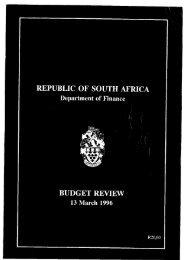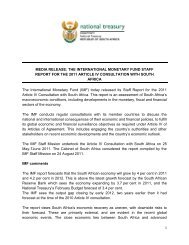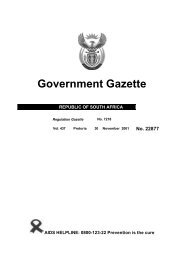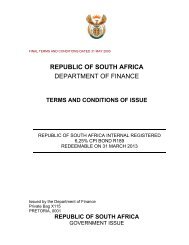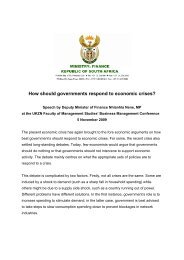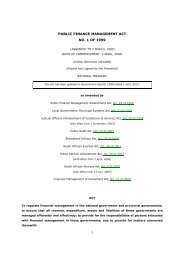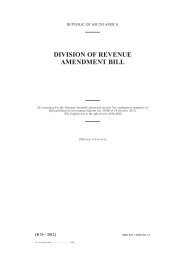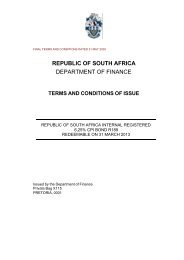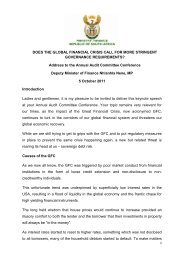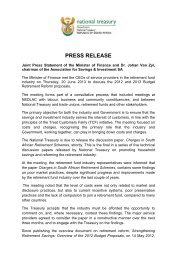1998 SOUTHERN AFRICA ECONOMIC ... - National Treasury
1998 SOUTHERN AFRICA ECONOMIC ... - National Treasury
1998 SOUTHERN AFRICA ECONOMIC ... - National Treasury
Create successful ePaper yourself
Turn your PDF publications into a flip-book with our unique Google optimized e-Paper software.
seasonality factors normally associated with an increase in<br />
i m p o rts during the fe s t i ve period.<br />
The Bank of Zambia took a bold decision to strengthen the<br />
financial we l l b e i n g ,and enhance confidence in the banking and<br />
financial system. F i r s t ly,a weak bank with liquidity pro b l e m s ,t h e<br />
Chase Trust Bank, was merged with the Zambia <strong>National</strong><br />
C o m m e rcial Bank, a large, s t rong bank. S e c o n d ly, t h re e<br />
c o m m e rcial banks namely, M a n i fold Bank, Prudence Bank and<br />
C redit Africa Bank, which we re insolve n t , we re put under<br />
re c e i ve r s h i p. All the remaining operating commercial banks have<br />
s t rong capital basics and are well managed.<br />
The overall balance of payment position re c o rded a deficit of<br />
USD138.9m in 1997 compared with a deficit of USD124.4m in<br />
1 9 9 6 . The trade deficit fell due to a rapid increase in<br />
m e rchandise exports re l a t i ve to merchandise import s . T h e<br />
i n c rease in exports came mainly from non-traditional export s<br />
(NTEs) which increased by 37.9 perc e n t .<br />
Financial Institutions<br />
Since independence,the Government of the Republic of Zambia<br />
maintained a ve ry active role in the banking sector. At the<br />
beginning of the 1990s the government started the process of<br />
opening up the economy, a l l owing the market fo rces to play an<br />
i m p o rtant ro l e. The financial sector was also liberalised during<br />
the same period.The Banking and Financial Services Act in 1994<br />
was designed to ensure a proper framework for regulating the<br />
conduct of the financial sector and the protection of clients and<br />
i nve s t o r s .<br />
The Bank of Zambia exe rcises overall control over the banking<br />
s y s t e m . The Bank’s main responsibility is the protection of the<br />
value of the country ’s curre n c y. M o n e t a ry control is being<br />
e xe rcised through indirect instruments such as open marke t<br />
o p e r a t i o n s .The Bank of Zambia is also responsible for the<br />
s u p e rvision of the banking industry and re forms aimed at<br />
s t rengthening the Bank’s superv i s o ry and re g u l a t o ry cap a c i t i e s<br />
we re implemented in 1997.<br />
Both local and international banks have a presence in Zambia.<br />
International banks operating in Zambia include Barc l ay s ,<br />
S t a n d a rd Chart e re d ,S t a n b i c, C i t i b a n k ,and the Bank of China.<br />
M a ny of the commercial banks also offer merchant and<br />
i nvestment banking serv i c e s .The introduction of automated and<br />
computerised services has improved the quality of the serv i c e s<br />
p rovided by the banking sector.The number of building societies<br />
is also grow i n g ,catering for small depositors and concentrating<br />
on long term mortgage loans.<br />
Z A M B I A<br />
The Development Bank of Zambia provides medium and long-<br />
Lusaka Stock Exchange - Market Statistics (USDm)<br />
term loan finance and equity.Also providing long-term capital in<br />
the form of loans and equity is the Zambia Ve n t u re Capital Fund,<br />
a private company established in 1995.<br />
Lusaka Stock Exchange<br />
The LuSE began operations in Fe b r u a ry 1994 and although in<br />
the first year no companies we re listed, trading of unlisted<br />
stocks took place. The exchange was officially opened in A p r i l<br />
1 9 9 5 . C u rre n t ly, s even companies are listed, the major ones<br />
being ZCCM, Zambia Sugar and Chilanga Cement.The Zambian<br />
government offers some tax incentives (detailed in the section<br />
on investment incentives) for companies which list on the<br />
e x c h a n g e.<br />
A unique fe a t u re of the Zambian stock market is that it was<br />
designed by the International Finance Corporation, as a unified<br />
m a r ke t .This is achieved through the Securities Act (1993) which<br />
re q u i res companies with 50 or more shareholders to re g i s t e r<br />
with the Securities and Exchange Commission (the agency<br />
responsible for the regulation of the capital market) and trade<br />
their shares on a recognised exchanges. In practice, this means<br />
that the LuSE operates as a central market with a two tier<br />
s t r u c t u re on which both listed and unlisted shares trade. T h e<br />
<strong>1998</strong> budget announced that dual listings would be provided fo r<br />
on the LuSE.<br />
The LuSE is designed to meet modern current international<br />
s t a n d a rds in terms of trading, clearing and settlement.The LuSE<br />
operates a central depository system and the trading<br />
mechanism is bro ker to bro ker order matching. Clearing is<br />
automated and completed on T + 1. Settlement is executed on<br />
a T + 3 rolling basis.<br />
The LuSE was one of the fastest growing bourses in Africa in<br />
1 9 9 7 , g rowing an impre s s i ve 208 percent in terms of marke t<br />
c ap i t a l i s a t i o n .The LuSE was also one of the best-perfo r m i n g<br />
m a r kets in 1997.<br />
Among the developmental plans under rev i ew is the fo r m a t i o n<br />
of a Unit Tr u s t , p o s s i b ly in <strong>1998</strong> to engage broad and wide<br />
p a rt i c i p a t i o n ,p a rt i c u l a r ly in the privatisation programme and as<br />
p a rt of effo rts to put in place the institutional structure of the<br />
m a r ket and develop the necessary skills.T h e re are also plans to<br />
facilitate the establishment of an active secondary market in<br />
government securities at the LuSE. This listing of gove r n m e n t<br />
bonds is expected to improve price formation as well as draw<br />
in broader participation by the public in the bond marke t .<br />
The Securities and Exchange Commission, which monitors and<br />
regulates the LuSE, is an independent body, whose board<br />
consists of six commissioners.<br />
Y E A R 1 9 9 4 1 9 9 5 1 9 9 6 1 9 9 7<br />
Number of companies with shares listed 0 2 3 7<br />
Number of quoted companies 5 6 5 3<br />
M a r ket cap i t a l i s a t i o n n / a 4 3 6 2 2 9 7 0 5<br />
Volume of shares traded (m) 3 . 9 3 7 . 9 2 2 4 1 . 3 8 2 6 9 . 2 6<br />
Value of shares traded 0 . 3 7 0 . 2 3 2 . 6 4 8 . 7 7<br />
A n nual average dividend yield n / a n / a n / a 3 . 9 3<br />
Average price-earnings ratio of all listed companies n / a n / a 4 . 67 9 . 68<br />
S o u rc e : Lusaka Stock Exchange (<strong>1998</strong>).<br />
98



